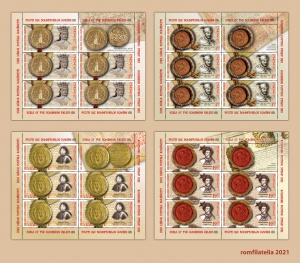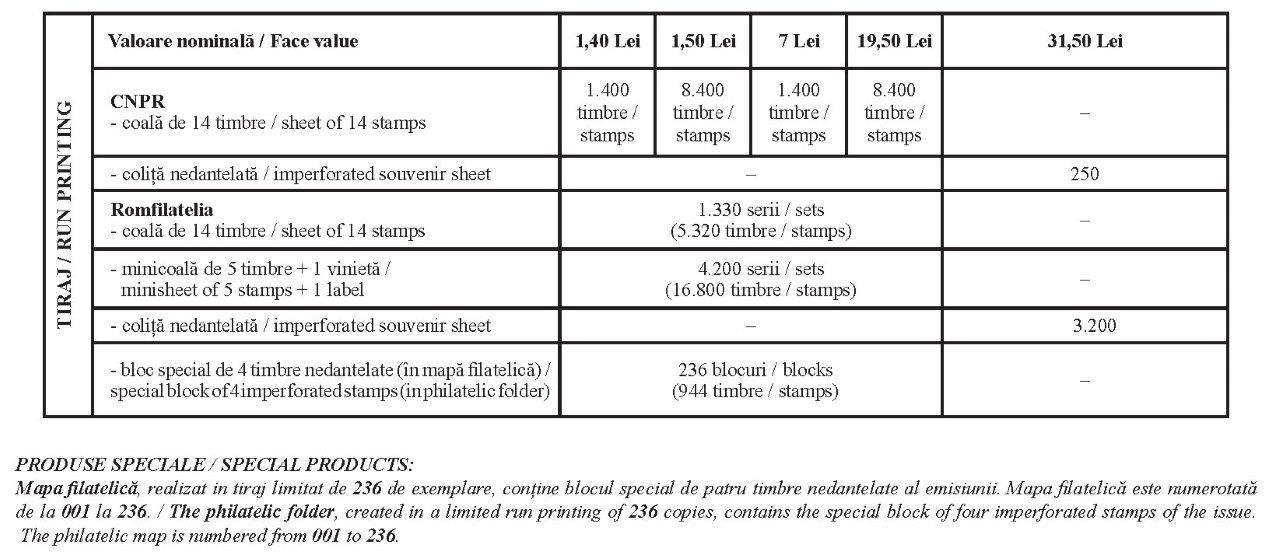 Continuing a theme initiated in the year 2019, Romfilatelia introduces into circulation, on Thursday, July 15th this year, the postage stamps issue Seals of the Romanian Rulers (II).
Continuing a theme initiated in the year 2019, Romfilatelia introduces into circulation, on Thursday, July 15th this year, the postage stamps issue Seals of the Romanian Rulers (II).
The documents drafted and written on paper or parchment, issued by the royal chancelleries of the Romanian Principalities, were validated, besides the holographic signatures, by the use of seals of different sizes. The royal seals usually applied in red wax took over the embossed elements of the seals and they themselves represented an object of study as they were protected in a wax scoop or in wooden or metal capsules.
The seals, elements that gave authenticity to the princely documents, show visible differences, if we refer to the royal courts of Moldavia and Wallachia. Thus, in Moldavia, the seal showed an aurochs’ head seen from the front with a star between the horns. In the chancelleries of Wallachia, the signets and seals had as a symbol the conturned cross-bearing eagle accompanied by the sun and the “new moon”.
The hanging seals that accompanied the documents of great importance issued in both Romanian territories were, generally, made of natural wax. But the most valuable category was represented by the metal seals which appeared at the middle of the 16th century. Known as sealing bulls or chrysobulls, they were of two types: simple metal capsules meant to protect the wax seal or real “golden bulls”, which had representations and inscriptions on the obverse and the reverse.
The seals, as an element of authenticity of the most important documents issued by the royal chancelleries, accompanied the external documents that legislated the treaties of alliance and the internal acts, such as the establishing of properties or the confirmation of royal donations.
Besides the wax seals and chrysobulls, we must also mention the authentication of the documents of princely chancelleries or those of the high officials and great boyars with seals in vermilion, made by applying the image of the metal seal (used as a stamp) with red mercury sulfide directly on parchment and under issuer’s signature. In this case, sometimes a drawn contour imitated the scoop of classic seals.Seals of the Romanian Rulers (II) stamps issue consists of four stamps and an imperforated souvenir sheet.
The four stamps of the series present wax seals and chrysobulls of some rulers of Wallachia from the 16th, 17th and 18th centuries: Petru Cercel, Radu Mihnea, Grigore I Ghica, and Constantin Brancoveanu. Each seal is accompanied by the portrait of the respective ruler, on the background being reproduced documents issued during the reigns of these Wallachian princes.
On the first stamp of the series, with the face value of Lei 1.40, is represented a chrysobull of Petru Cercel, from the collections of the National Museum of Romanian History, on the background being reproduced a document signed by this ruler, in the National Archives of Romania. Petru Cercel (Petru Patrascu), ruler of Wallachia (1583-1585), was the second son of Patrascu the Good. During his short reign, he moved the capital of Wallachia from Bucharest to Targoviste, after having rebuilt the constructions of the old royal court. He was concerned with the organization and outfitting of the army. After the Turks had removed him from office, he retreated to Transylvania.
On the second stamp of the issue, with the face value of Lei 1.50, is illustrated a red wax seal of Radu Mihnea. He was a ruler of Wallachia for several times between 1601 and 1623 and he also occupied the throne of Moldavia for a short period of time, between 1616 and 1619 and between 1623 and 1626. He had a submissive behavior in relation to the Ottoman Empire, being especially supported by representatives of the Greek boyars, in conditions of hostile manifestations of the local boyars. He initiated measures to liberate the serfs called rumâni (peasants dependent on their feudal lords). The seal and the document in the background are found in the collection of the Romanian Academy.
On the third stamp of the series, with the face value of Lei 7, is represented a chrysobull of Grigore I Ghica. He came from an important family of boyars of Albanian origin, which had an important public role in the 17th and 19th centuries. He ruled Wallachia between 1660 and 1664 and between 1672 and 1673. The chrysobullaand the document in the background are found at the Romanian Academy.
On the fourth stamp of the issue, with the face value of Lei 19.50, is represented the seal of Constantin Brancoveanu. Being on the throne of Wallachia for a long period of reign (1688-1714), Constantin Brancoveanu provided the country with a stable state of peace, cultural flourishing and development of the spiritual life, leaving as evidence a large number of religious foundations and an eclectic architectural style which bears his name. The seal and the document on which it is applied are found in the collection of the Romanian Academy.
On the imperforated souvenir sheet, with the face value of Lei 31.50, is represented (obverse and reverse) the chrysobulla of Grigore I Ghica, especially valuable, one of the few such objects extant in our country. It has on its obverse the text “Io, Gligorie Ghica, Voivode of the whole Wallachia in the year 7172” (1664), and on the reverse “This chrysobull was made by Io, Gligorie Ghica, Voivode, to the whole Athonite State and of 20 holy monasteries that are around the Holy Mount Athos in the year 7172” (1664).
Romfilatelia thanks the Romanian Academy Library, the National Museum of Romanian History, the National Archives of Romania and museologist dr. Sorin Iftimi at the „Moldova” National Museum Complex in Iasi for the support granted in the development of this postage stamps issue.



